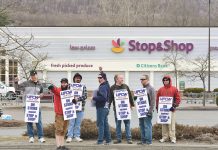
via ROAR magazine
by Jared Sacks
Depending on one’s capacity for optimism, 2018 either foretold the rebirth of labor militancy in the United States or, conversely, suggested the last gasp of a movement that has been in near-terminal decline since the 1970s. Two key events took place last year, which, per one’s analysis, have led to opposing predictions for workers in the US.
First, in February 2018, after years of austerity under Republican control, West Virginia teachers and school personnel decided to go on strike. But this was no conventional work stoppage. In West Virginia, teachers are considered providers of “essential services”, making any strike action illegal. Of course, this is part of the reason why neoliberal politicians have been able to walk all over the backs of West Virginia teachers for decades, making them third-last in the nation in terms of pay.
However, it also did not help that their unions — the American Federation of Teachers, the National Education Association and the West Virginia School Service Personnel — were all dead set against any risk-taking, never mind an illegal disruption of work.
But against all expectations, West Virginia teachers captivated the nation when they decided to go on strike nonetheless, drawing inspiration from a long history of radical strikes in the state’s dying coal-mines. Their wildcat action brought out over 20,000 teachers shutting down schools in all 55 West Virginia counties.
This turned public opinion against the government — instead of no pay increase at all, they ultimately won their “impossible” demand for a 5 percent pay raise. Immediately, an organizing wave erupted throughout the nation, including follow-up actions by teachers in Arizona, Oklahoma, Colorado and North Carolina.
Then, a second key event took place: in June 2018, the US Supreme Court ruled against workers in the landmark case Janus v. AFSCME. The ruling, which had been pushed by conservative advocacy groups, including those affiliated with the billionaire Koch brothers, reversed the 1977 Abood v. Detroit Board of Education decision which allowed labor unions to charge agency fees to non-members who benefited from the contracts unions negotiated on their behalf. Labor unions argue that such agreements have proven essential to preventing the common “free-rider” problem.
Post-Janus predictions were grim. The largest unions in the nation, like the SEIU, UAW and NEA, estimated a loss of tens of millions of dollars as well as between 10 to 30 percent of their membership. It was feared that this was the beginning of the end: emboldened conservative NGOs, they believed, would try to ram through further anti-union legislation, expand their “fake news” propaganda, and make it nearly impossible to organize in the workplace.


































